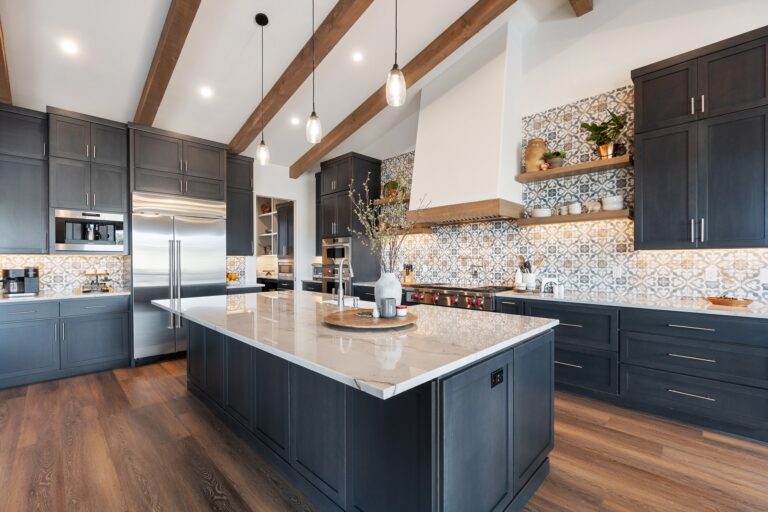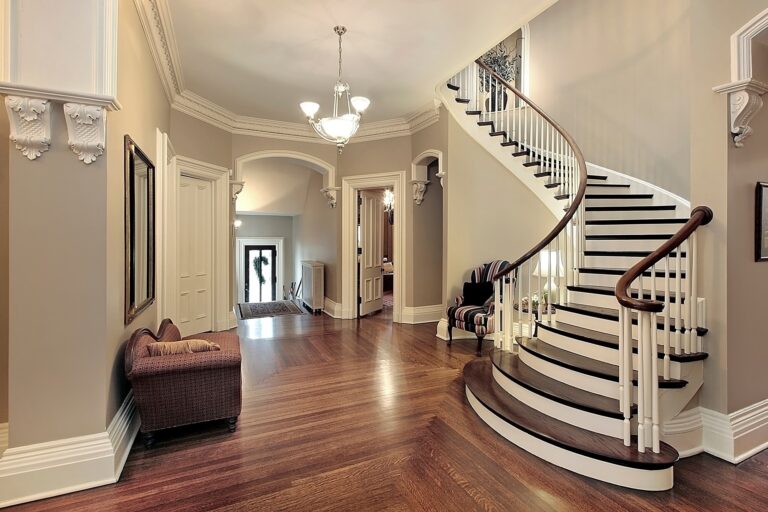Floor plans are an essential element of interior design, guiding you through space planning and layout with precision. Whether you’re mocking up a new layout or reviewing plans with an architect, knowing how to read floor plans and speak the same language is key to doing your job well.
This guide covers 36 important floor plan symbols to help you navigate your design projects with confidence.
Table of Contents
36 Floor plan symbols every designer should know
Some floor plan symbols may feel intuitive, while others have a steeper learning curve. Browse through this list as a helpful starting point (or a quick refresher), and be sure to bookmark it for easy reference if you have questions.
Walls
#1: Permanent walls or partitions: Solid lines outlining where the room is located.
#2: Non-permanent wall of half-wall: Dashed lines are often used to indicate half walls, railings, or temporary partitions.
#3: Closets: Squares, rectangles, or L-shaped boxes along walls outlining closet barriers.
Doors
#4: Single Door: A straight line with a small arc indicating the swing direction.
#5: Double Door: Two parallel lines with arcs on either side indicating the swing.
#6: Sliding Door: A solid line with a double arrow indicating the sliding motion.
#7: Pocket Door: Similar to a sliding door but indicated with a dotted line, showing the door disappearing into the wall.
Windows
#8: Rectangular Window: A double line (representing the wall) with one space showing the window opening.
#9: Casement Window: A window that swings outward, represented by a rectangle with a small arc on one side.
#10: Bay Window: A projection from the wall represented by a series of lines or a rounded shape, indicating an angled window.
Stairs
#11: Staircase: A series of parallel lines representing the steps, often with arrows showing the direction of movement.
#12: Landing: A flat area at the top or bottom of the stairs, represented as a short horizontal line.
#13: Railing: Lines alongside the edges of the stairs to show handrails and/or guardrails.
Furniture
#14: Sofa: A rectangular shape with curved or straight sides, labeled as “Sofa or SF.”
#15: Chair: A small rectangle or circle, often labeled “Chair, CH, or CHR.”
#16: Table: Represented by a rectangle or circle depending on shape (e.g., round or square).
#17: Bed: A long rectangle, usually labeled with the size (e.g., “King Bed” or “Queen Bed”).
Fixtures
#18: Toilet: Usually shown as a circular shape with a seat outline, sometimes labeled with ‘WC’ or ‘Toilet’ depending on the drafting style.
#19: Sink: A small rectangle or circle with a line indicating the plumbing.
#20: Shower/Tub: Represented by a rectangle with a curving side to show the edge of the shower/tub.
#21: Bathtub: A rectangle with one side rounded, indicating the tub’s shape.
#22: Kitchen Sink: Often drawn as a rectangle or square, sometimes with a dividing line to show a double-basin sink.
#23: Range: A Rectangle with 4-6 circles representing the burners.
Electrical symbols
#24: Light Fixture: A small circle or a symbol with a line indicating the fixture’s position.
#25: Switch: Often marked as an ‘S’ or an abbreviation, sometimes with a dashed line pointing to the light it controls.
#26: Electrical Outlet: A small circle or rectangle with two lines for a power outlet.
#27: Ceiling Fan: A circle with three or four blades drawn as arcs.
Elevations and sections
#28: Elevation: Representing the exterior or interior view of a building’s facade, shown with a vertical line and labels.
#29: Section: The section cut line is usually marked with a bold dashed line and arrows pointing in the direction of the view. It’s labeled ‘Section A-A’ or similar.
Structural elements
#30: Columns: A circle or square showing the position of a structural column.
#31: Beams: A line with an indication of the beam’s location.
Airflow and ventilation
#32: Air Vents: A rectangle or circle with lines radiating outward to indicate supply and/or return vents. Some HVAC professionals draw return vents larger and more square than supply vents.
Outdoor elements
#33: Deck/Patio: Typically represented by dashed lines or a shaded area labeled ‘Deck’ or ‘Patio,’ often noted outside the main wall outline.
#34: Garden/Planting Area: Small plant symbols or shading to represent greenery. More likely to appear in site plans than architectural floor plans.
Dimensions and annotations
#35: Dimensions: Numbers showing the length or width of a room or furniture.
#36: Text Labels: Provide information such as room names (e.g., “Living Room,” “Kitchen”) or specific notes on design or materials. Things like “Primary Bath” or “Pantry” help clarify the purpose of a room, especially on busy plans with lots of symbols.
Tips for reading floor plans
Keep reading for tips to help you make sense of floor plans.
1. Understand the dimensions and scale
Floor plan scales indicate the proportional relationship between the paper dimensions and the actual size of the space. Be sure to check for a key that explains this ratio, such as “1 centimeter = 1 foot,” so you can accurately interpret the scale of the drawing.
2. Analyze the layout
Floor plans give you a sense of walking through the space, helping you understand room purposes, traffic flow, natural light, and privacy needs. Pay attention to how rooms are arranged to grasp their function, where doors and passageways are placed to optimize movement, and where natural light enters. Consider privacy in areas like bedrooms and bathrooms, thinking about walls or door placements to maintain seclusion.
3. Keep a go-to guide on floor plan symbols and abbreviations
Much like symbols, some floor plan abbreviations are straightforward, while others can be tricky. Keep your favorite resources bookmarked so you can easily refer to them whenever you have questions.
Keep in mind: different contractors and architects may use varying symbols for the same elements. If you’re still unsure after researching, don’t hesitate to reach out to the building team to ensure you’re interpreting everything correctly.
FAQs about floor planning
Interior designers create floor plans, but they differ from architectural floor plans. Architects design floor plans that focus on structural elements like walls, windows, and doors, ensuring the space is safe and compliant with building codes. In contrast, an interior designer’s floor plan emphasizes functionality and aesthetics, such as furniture layout, lighting, and space flow.
If you hear your contractor or architect talking about elevations, rest assured that they aren’t looking for your floor plan. Elevations provide a straight-on view of a building’s exterior or interior walls, showing details like windows, doors, and finishes, whereas a floor plan is a top-down view that shows the layout of rooms and spaces.
While it’s crucial for interior designers to understand the floor plans of the spaces they’re designing, there’s no need to memorize every abbreviation and symbol. Keep handy guides like this one bookmarked, and don’t hesitate to ask architects and contractors for clarification whenever needed.
Looking for more go-to guides? Check out these DesignFiles resources on interior design abbreviations and interior design styles.
Whether you’re drafting layouts yourself or reviewing plans from a builder, knowing how to read and interpret symbols will make collaboration smoother—and platforms like DesignFiles let you bring those plans to life in 3D to help clients visualize the space.
Want to create stunning 3D floor plans for your clients? Check out DesignFiles, the top-rated solution for solo designers and small firms.


